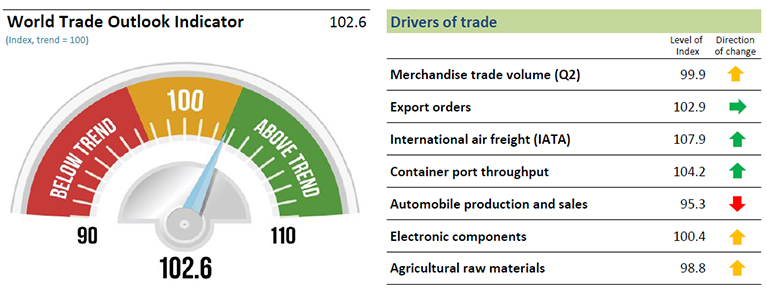
According to the WTO (World Trade Organization), latest indicators of the global merchandise trade growth will continue to strengthen in the third quarter of 2017. There are positive expectations regarding performances in air freight, export orders, and container shipping. The WTO indicator is designed to provide “real time” information on the trajectory of world trade relative to recent trends.
The current trend in trade growth is the highest level of the indicator since April 2011. Global trade forecast is clearly showing that trade volume growth will continue to be strong in the third quarter of 2017. Growth in export orders, air freight, and container shipping are leading the upward trend in the indicator as economic activity recovers around the world. While agricultural raw materials and electronic components trade have been weaker, both categories have improved recently. On the other hand, slow growth in the automotive industry production and sales is maybe a signal of weakening consumer confidence. Global export orders are at the top historical peak this year. If this is the case, trade growth would be expected to moderate during next year.
Positive global trade forecast
These results are more positive than the WTO’s most recent trade forecast of April 2017, which anticipated moderate trade growth this year after weak expansion last year. The WTO indicator is not intended as a short-term forecast, although it does provide an indication of trade growth in the near future. Its main contribution is to identify turning points and gauge momentum in global trade growth. As such, it complements trade statistics and forecasts from the WTO and other organizations. Readings of 100 indicate growth in line with medium-term trends; readings greater than 100 suggest above-trend growth, while those below 100 indicate the reverse. The direction of change reflects momentum compared with the previous month.

Global trade trends are mainly set in the three major production hubs – the United States, Asia, and Europe. For individual countries, the trade volume depends on the following factors: who a country’s trading partners are, how far the country is from high-income markets, and the degree to which partners are integrated within regional global value chains.
New Trade Agreements
During last month the WTO members reviewed three Regional Trade Agreements as part of their efforts to push the multilateral trade agenda. Members considered the Korea-Vietnam Free Trade Agreement, the Deep and Comprehensive Free Trade Area between the European Union and Ukraine, and the Georgia-Russia Free Trade Agreement at the meeting of the Committee on Regional Trade Agreements. The trade agreement between EU and Ukraine covering both goods and services is particularly important. Together with a substantial liberalization of trade in goods and services, the agreement also regulates public procurement and intellectual property protection. The Agreement entered into force on 23 April 2014 for the European Union and 1 January 2016 for Ukraine.
Thank you for reading our articles, stay informed about the industrial world and Exapro by following us on Exapro Hub, Facebook, Twitter and LinkedIn.



